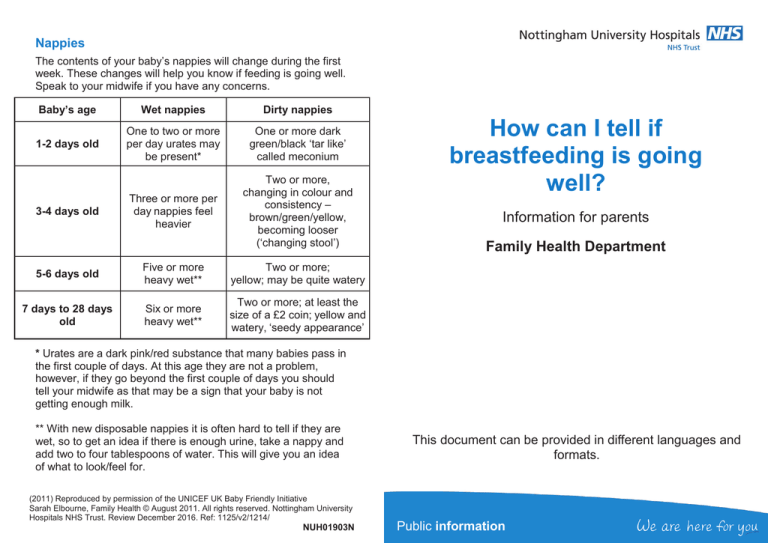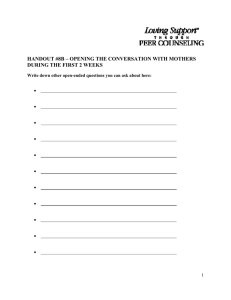
Nappies
The contents of your baby’s nappies will change during the first
week. These changes will help you know if feeding is going well.
Speak to your midwife if you have any concerns.
Baby’s age
Wet nappies
Dirty nappies
1-2 days old
One to two or more
per day urates may
be present*
One or more dark
green/black ‘tar like’
called meconium
Three or more per
day nappies feel
heavier
Two or more,
changing in colour and
consistency –
brown/green/yellow,
becoming looser
(‘changing stool’)
3-4 days old
5-6 days old
Five or more
heavy wet**
Two or more;
yellow; may be quite watery
7 days to 28 days
old
Six or more
heavy wet**
Two or more; at least the
size of a £2 coin; yellow and
watery, ‘seedy appearance’
How can I tell if
breastfeeding is going
well?
Information for parents
Family Health Department
* Urates are a dark pink/red substance that many babies pass in
the first couple of days. At this age they are not a problem,
however, if they go beyond the first couple of days you should
tell your midwife as that may be a sign that your baby is not
getting enough milk.
** With new disposable nappies it is often hard to tell if they are
wet, so to get an idea if there is enough urine, take a nappy and
add two to four tablespoons of water. This will give you an idea
of what to look/feel for.
(2011) Reproduced by permission of the UNICEF UK Baby Friendly Initiative
Sarah Elbourne, Family Health © August 2011. All rights reserved. Nottingham University
Hospitals NHS Trust. Review December 2016. Ref: 1125/v2/1214/
NUH01903N
This document can be provided in different languages and
formats.
Public information
Breastfeeding is going well when:
Your baby has 8 feeds or more in 24 hours
Talk to your midwife if:
Your baby is sleepy and has had less than 6 feeds in 24 hours
Your baby is feeding for between 5 and 30 minutes at each feed
Your baby consistently feeds for 5 minutes or less at each feed.
Your baby consistently feeds for longer than 40 minutes at each
feed
Your baby always falls asleep on the breast and/or never finishes
the feed himself
Your baby appears jaundiced (yellow discolouration of the skin)
- most jaundice in babies is not harmful; however, it is important to
check your baby for any signs of yellow colouring particularly
during the first week of life. The yellow colour will usually appear
around the face and forehead first and then spread to the body,
arms and legs. A good time to check is when you are changing a
nappy or clothes. From time to time press your baby’s skin gently
to see if you can see a yellow tinge developing. Also check the
whites of your baby’s eyes when they are open and the inside of
his/her mouth when open to see if the sides, gums or roof of the
mouth look yellow.
Your baby has normal skin colour
Your baby is generally calm and relaxed whilst feeding and is content after most feeds
Your baby has wet and dirty nappies (see chart over page)
Breastfeeding is comfortable
When your baby is 3 to 4 days old and beyond you should be able
to hear your baby swallowing frequently during the feed
2
Your baby comes on and off the breast frequently during the feed
or refuses to breastfeed
Your baby is not having the wet and dirty nappies explained
overleaf
You are having pain in your breasts or nipples, which doesn’t
disappear after the baby’s first few sucks. Your nipple comes out of
the baby’s mouth looking pinched or flattened on one side
You cannot tell if your baby is swallowing any milk when your baby
is 3 to 4 days old and beyond
You think your baby needs a dummy
You feel you need to give your baby formula milk
3



